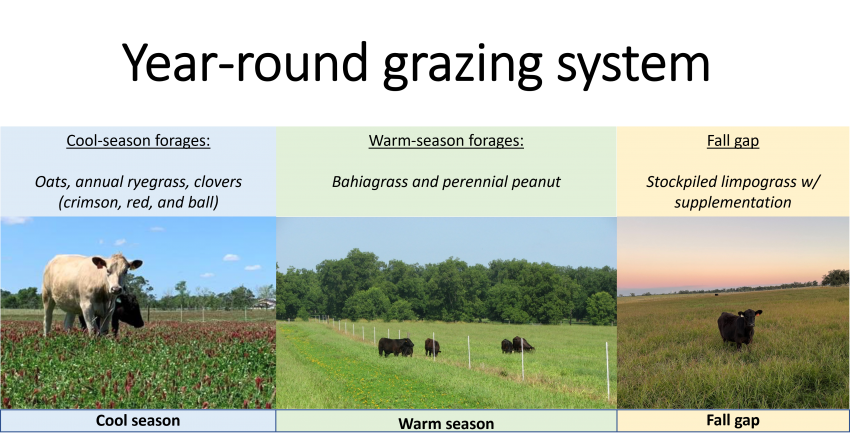Jose Dubeux, L. Queiroz, D. Jaramillo, L. Garcia, E. Santos, I. Bretas, M. Bernardini, K.R. Trumpp, J. Portuguez, H. Koury, K. Oduor, M. Ruiz-Moreno, North Florida Research and Educaiton Center – Maraianna
Introduction
Is it possible to graze livestock on forages year-round in North Florida? The short answer is, YES! We are not trying to reduce the importance of conserving forages as silage or hay, which is always important because of the weather uncertainties we often face. However, if grazing is possible throughout the year, we should try to develop such a system because of the reduced reliance on off-farm inputs and the cost savings that come from growing feed for livestock rather than purchasing it. Cattle return most of the nutrients (80-90%) back to the soil when they are grazing, reducing the need for larger amounts of industrial fertilizer application. Harvesting costs are also eliminated, since the grazing animals will do the job! Furthermore, labor, machinery use, and fossil fuels can also be minimized in year-round grazing systems. This seems too good to be true! The truth is that you won’t be able to accomplish this goal with bahiagrass pastures alone. You will need to diversify your forage species, improve your management, and rotate some areas within the farm.
This year we had proof of concept at UF/IFAS NFREC Marianna that it is possible to develop year-round grazing systems by having a bahiagrass pasture overseeded with cool-season forages, with stockpiled limpograss to bridge the fall forage gap (Figure 1). This can’t be achieved all on the on the same ground though. You will have to establish an area of limpograss to fill the fall gap, around 20-30% of the total pasture area. So, if you have 50 acres of bahiagrass you may need to establish 10 to 15 acres of limpograss, and overseed the bahiagrass with cool-season forages. Forage legumes could be the “cherry on the cake” by adding nitrogen (N) and reducing N fertilizer costs. Clovers during the cool-season and rhizoma peanut during the warm season add higher quality nutrition while also reducing N fertilizer costs.
–
Describing the system
Bahiagrass is the most common perennial grass in Florida, and it is the backbone of livestock operations across the state. It typically produces the most growth from May-June to September-October of each year. Livestock gains on a bahiagrass monoculture are typically 0.7 to 0.8 lbs./hd/d. Mixing bahiagrass with rhizoma perennial peanut increased the average daily gain (ADG) from 0.7 to 1.3 lbs./hd/d, resulting in greater gain per area (≈350 lbs./acre during the summer vs. ≈250 lbs./acre for unfertilized bahiagrass (Jaramillo et al., 2021). In the cool-season (January to May), a mixture of grass (oats, annual ryegrass) and clovers (crimson, red, and ball) resulted in ADG of approximately 2 lbs./hd/d and gains per area of ≈250 lbs./acre (Jaramillo et al., 2021). This system, including warm and cool seasons and integration of forage legumes, required only 30 lb N/acre/yr of commercial fertilizer, with the legumes helping to add more nitrogen via biological N fixation. This system averaged 1.5 lbs./hd/d on the warm and cool season combined, which is in the range needed for developing heifers. The fall gap could be addressed with stockpiled limpograss. Limpograss stockpiling works well because it loses its digestibility at a slower pace compared with other perennial grasses such as bahiagrass or bermudagrass (Santos et al., 2022). Crude protein (CP) concentration on stockpiled limpograss, however, will be low. Supplementation strategies using liquid feed or other type of supplement with higher CP concentration is a possible alternative to enhance livestock gains on stockpiled limpograss.
Recently we finished a grazing trial at UF IFAS NFREC Marianna with growing steers on stockpiled limpograss. We started the stockpiling period on August 21, 2022, after staging and fertilizing the pastures. We applied 60 lbs.N/acre and P, K, and S as recommended by the soil test at the beginning of the stockpiling period. Cattle started grazing by October 21, 2022. Animal performance in this trial ranged from 0.9 lbs./hd/d for steers grazing stockpiled limpograss without any supplementation up to 1.4 lbs./hd/d when protein supplementation was provided. The gains per area ranged from ≈200 lbs./acre for the unsupplemented steers to ≈300 lbs./acre for steers receiving 2 lbs./d of a cube supplement with 32% crude protein. Putting all together, we have a system with potential to reach ≈800-900 lbs./acre/yr with year-round grazing (Table 1).
Take-Home Message
It is possible to develop year-round grazing systems in North Florida by diversifying forage species and intensifying management practices. Limpograss can fill the fall forage gap if stockpiled, but requires a separate pasture in addition to the primary bahiagrass pastures. Integrating legumes can reduce the input of commercial N fertilizer, improve animal performance, and enhance the delivery of ecosystem services.
–
Reference
Jaramillo, D.M., J.C.B. Dubeux, Jr., L.E. Sollenberger, J.M.B. Vendramini, C. Mackowiak, N. DiLorenzo, L. Garcia, L.M.D. Queiroz, E.R.S. Santos, B.G.C. Homem, F. van Cleef, M. Ruiz-Moreno. 2021. Water footprint, herbage, and livestock responses for nitrogen-fertilized grass and grass-legume grazing systems. Crop Science, 61:3844-3858. https://doi.org/10.1002/csc2.20568
Santos, E.R.S., J.C.B. Dubeux, Jr., D.M Jaramillo, L. Garcia, J. Vendramini, N. DiLorenzo, L.M.D. Queiroz, J.D. Pereira Neto, D.S. de Abreu, M. Ruiz-Moreno. 2022. Herbage accumulation and nutritive value of stockpiled limpograss and ‘Tifton 85’ bermudagrass. Crop, Forage & Turfgrass Management, 2022; 8:e20140 https://doi.org/10.1002/cft2.20140
- 2025 UF/IFAS Forage Legume Conference – May 1 - March 28, 2025
- How are My Cool-season Forages Recovering from the Snowfall and Low Temperatures? - January 31, 2025
- Integrated Crop-Livestock Systems Improve Soil Health - July 26, 2024


